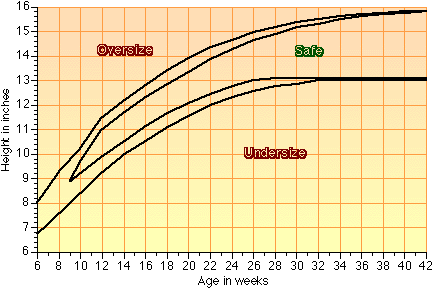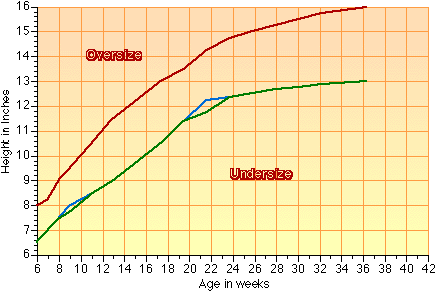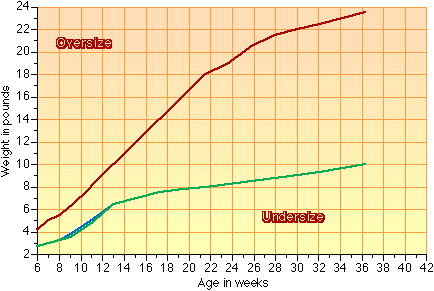Sheltie Size
Shetland Sheepdogs are one of the few breeds with an absolute disqualification on size. At the same time, the breed as it now exists has within the last century and a half or less combined breeds ranging in size from papillions and English Toy Spaniels to full-sized Collies. The allowed size range has changed during the development of the breed, generally moving upward from a one-time maximum of 12" as more and more Collie genes were incorporated. (The actual sizes were often much larger, especially during the period when Collie crosses were common.) But the desired size range is achieved by balancing genes from large and small breeds, and consequently breedings in which both parents are the correct size can produce puppies much larger or smaller than desired. As one result, Shetland Sheepdog breeders tend to become obsessed with measuring the size of their puppies, and a number of growth charts have been developed to estimate adult size from measurements made at various ages. Replots of the Sea Isle, Nobel and Pow (Ch Cherden Sock It To 'Em CD ROM) line charts are shown here.
One of the oldest charts is the Sea Isle chart, especially as modified by Jo Parker. This chart checks for potential oversize only, and does not give any "maybe" zone except at the very top, where there are separate lines for strains that stop growing by six to eight months and those that may continue to grow until they are as much as a year and a half old. (Note also that bitches normally stop growing earlier than dogs, so the upper line is useful for the girls.) The green triangle shows the 10-week - 10 inch decision point for Macdega and Barwood; the blue diamond is the 9-week - 9 inch point used at September Shelties.
Sea Isle Growth Chart. Based on the same numbers as the one included in Sheltie Talk
In recent years the Nobel chart has become popular. This chart includes two sets of limits, one for potential oversize and the other for potential undersize, as well as an "iffy" range at both the upper and lower limits. Note that this chart does not define any safe range prior to almost 10 weeks of age.
Nobel size chart, replotted from the data in the back of the Shetland Sheepdog calendarA third chart is specifically for lines with heavy Pow (Ch Cherden Sock It To 'Em CD ROM) breeding, and is based on statistics collected by Cheryl Anderson and sent to me by Nora Borgstrom. Pow was the result of crossing a dog heavily linebred on Golden Note/Timberidge/Geonimo lines (Ch Diamond's Robert Bruce ROM) with a bitch who combined Page's Hill with Ch Thistlerose Arcwood Aladdin (Pocono/Thistlerose).
Pow line height chart (use in conjuction with weight chart below) The blue and green lines give separate values for male and female pups.
Pow line weight chartNora Borgstrom says the following about this chart:
"The first type (slower maturing) appears smaller,finer boned, but still has that chiseled headpiece and plenty of muzzle and underjaw. Through puppyhood and even teen stages it appears weedy, no coat to speak of,but still has that "look of promise." This type once it has reached maturity will never "go off". At ten or twelve the look and body are still there,and the head piece never coarsens. The second (faster maturing) type is the one that you sometimes worry and fret "Will he stay in?" type.Very often they will be at the top of the chart or even a little over through early growth stages, so you will use the weight to gage the final outcome. If they are a little over chart in the height department but are okay weightwise it's a good chance they will stay in. It's never a sure thing in the boys especially but once youve seen a few of these chancy ones, you begin to "just know" which are going to stay in.Not too many puppy bloomers in the POW line but as I said when they finally mature they don't change. The second type of growth seems to produce the "stallion like" male. The first type tends to produce more moderately."Different Sheltie lines do follow different growth patterns, so if anyone has information on growth rates for other specific lines, I'll post them too. Of course most Shelties today are combinations of a number of lines, and line crossing can produce growth patterns (especially in the second generation) that are quite different from either parent strain. Note also that with any chart it is wise to look at how fast the dog is growing relative to the rate shown on the chart as well as how tall the dog is.
Size is measured at the highest point of the shoulder blades, just behind the base of the neck. The dog should be measured standing on a hard, level surface with the front legs vertical and the head in a natural position. The ideal measuring device is an adjustable wicket or guillotine standard, but for the owner of a single Sheltie, the easiest way is to tape a yardstick to a wall with the 0" mark against the floor. Then take a drawing triangle or a rectangle of cardboard (the cardboard backing from a pad of paper works fine) and hold an edge against the yardstick above the height of the dog. Stand the dog with its front feet lined up with the yardstick and slide the triangle or rectangle down until it just rests on the withers. Read the dog's height from the yardstick at the bottom edge of the cardboard.
Some historical perspective on the size problem might be in order.
Shetland Collie Club (1908) "height shall not exceed 15 inches...A register shall be kept of members' dogs 12 to 15 inches."
Scottish Shetland Collie Club (1909) "height about 12 inches and weight from 10 to 14 pounds" but seems to have been interpreted as a 12 inch maximum height.
Dogs benched at Crufts in 1910 ranged from 13 to 16 inches at the shoulder
Crufts 1911 longer, lower dogs, 10 to 12 inches
Scottish Shetland Collie Club (1913) ideal height 12 inches
English Shetland Collie Club (1914) ideal height 12 inches
Scottish Shetland Collie Club (1914) ideal height 12 inches at maturity, fixed at 10 months. (Smooth coated specimens were explicitly barred for the first time in the same year.)
English Shetland Sheepdog Club (1923) From 12 to 15 inches, the ideal being halfway.
American Shetland Sheepdog Association (1929) 12 to 15 inches
American Shetland Sheepdog Association (1934) resolution passed that all Shetland Sheepdogs be measured in the ring and those over 15 inches be penalized accordingly. AKC refused.
American Shetland Sheepdog Association (1936)
Gentleman's agreement not to show dogs over 16 inches.
American Shetland Sheepdog Association (1937?) Gentleman's agreement formalized and 13 1/2 inch ideal height stated explicitly.
(The above taken from Catherine Coleman's book on the breed.)
American Shetland Sheepdog Association (1952) 13 to 16 inches with a disqualification for any dog measuring under 13 or over 16 inches. It is worth pointing out that the Sheltie is one of the very few breeds with the same size specified for dogs and bitches. Note also that the committee that wrote the new standard wanted a 15 1/2 inch upper limit. It is somewhat ironic that the ideal height over much of the breed's history (13 1/2 inches) would be considered too small to show by most breeders today. (Source: 1977-78 ASSA Handbook)
English Shetland Sheepdog Club (1965) Ideal height 14 inches for bitches and 14 1/2 inches for dogs, anything more than an inch above these heights to be considered a serious fault. The wording of the standard was changed in 1986 to put height in cm, but the actual height remained unchanged. (Source: 1970 and 1990 ESSA Handbooks). Note that almost every country except the United States and Canada uses these size limits.
I have a copy of the 1934 ASSA catalog with heights marked. Here are some adult heights more than an inch and a half from the 13 1/2 inch ideal:
Novice dogs: 2 entered, both in size.
American bred dogs: 7 entered; 3 over (1st place Wee MacGregor of Anahassitt 15 1/2; 4th place Neilsland Nuffsaid 15 1/2 inches; Rowcliffe Rip 17)
Limit dogs: 4 entered, 1 over (4th place Saruh 15 1/4)
Open dogs 1 entered, in size - Gigolo of Anahassitt 14 3/4 inches (eventual best of breed)
Novice bitches 5 entered, 4 oversize (1st place Weetamoe o'Page's Hill 16 7/8, 3rd Cynthia 17 1/4, 4th Topaz o'the Hills 17 7/8; Brenda 15 1/2)
American Bred Bitches 9 entered, 4 oversize (1st place Weetamoe o'Page's Hill 16 7/8; 2nd place Anahassitt Adoration 15 5/8; Pheemie 15 3/4; Sheltieland Sweetbriar 15 3/4)
Limit Bitches: 4 entered, 1 over (2nd place Ardeth of Anahassitt 15 3/4)
Open Bitches: 4 entered, 1 over (2nd place Alice of Anahassitt 15 1/4)
The Specials were Ch Mowgli ROM (15 3/8), Ch Bodachan of Clerwood (no height available) Ch Sprig of Houghton Hill (12 7/8) and Ch Helensdale Sapphire (15 1/2).
Note that Sprig, who would be disqualified for undersize under today's standard, was the only one of the three measured specials that was in size under the (unenforced) standard of his day: 12 to 15 inches, ideal 13 1/2 inches.
Dogs whose names are in italics are behind modern ROM Shelties.
last update October 29, 1997




